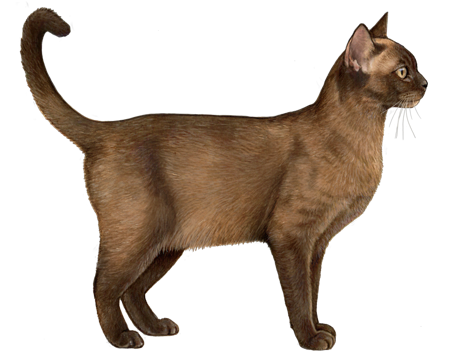
Toybob
Toybobs are small cats with big hearts and charming personalities. Affectionate, playful, and entertaining, they make excellent pets and cuddly companions.
Interested in discovering if your cat is a Toybob?
Check out Wisdom Panel's DNA test.
Toybob Traits
General Appearance
The Toybob is a naturally small cat with a compact, muscular body and bobbed tail. Fully grown, the breed is comparable in size to a six-month-old (or younger) domestic cat.
Coat and Coloring
Toybobs can have either a long or short coat. The shorthair coat is soft and slightly plush. It has a developed undercoat and doesn't lie close to the body. In contrast, longhair coats are softer with a minimal ruff and ear and feet furnishings. Both coat types come in all colors and patterns.
Distinctive Physical Traits
The Toybob's tail is at least one inch long, but it can extend down to the hock. It's bobbed with a combination of kinks and curves. Other key features of the breed include a modified wedge-shaped head with round contours, a square-shaped muzzle, medium-tall ears, and large, expressive eyes.
Toybob Temperament
Toybobs make great pets thanks to their gentle, quiet nature and happy disposition. They're affectionate and well-suited for just about everyone—from families with kids to single senior citizens.
These curious kitties like to follow their humans around and keep tabs on what everyone is doing. And when they want to get a bird's eye view, they have no trouble climbing atop a high bookshelf. Though playful, Toybobs aren't as high-energy as some other breeds. After short play sessions, they're thrilled to snuggle up in a lap and be pampered.
Toybob History
Toybobs originated in Russia in 1983. Their story began when Elena Krasnichenko found a stray cat that looked like a Siamese with a short, kinked tail. Two years later, Elena's mother took in a seal-point female with a curled bobtail.
Elena and her mother decided to breed the two adopted cats. And the resulting kitten was a small bobtailed male that Elena named Kutciy. Elena entered Kutciy in his first cat exhibition in 1989, and people mistook the mature cat for a kitten.
Development of the breed—dubbed Toybob by a World Cat Federation judge—continued over the next few decades as breeders expanded the gene pool and introduced new colors and patterns. In 2019, the CFA accepted the Toybob in the Miscellaneous class, making it the association's 45th recognized breed. Today, all Toybobs can trace their ancestry back to Kutciy.
Toybob Care
Nutrition
Toybobs require a high-quality diet. Because nutritional needs vary for kittens, adults, and senior cats, opt for a formula that's age-appropriate for your pet.
All cats are at risk of obesity if they overeat. One easy way to avoid overfeeding is to measure out meals and reduce portions if necessary. And be sure to account for calories from treats—those can add up fast for a little cat like the Toybob. As a guideline, treats should make up no more than 10% of a cat's caloric intake.
Lastly, all cats need access to fresh, clean water around the clock.
Grooming
The Toybob's coat is relatively low maintenance, regardless of length. Brushing once or twice a week is typically enough to remove dirt and loose fur. During periods of seasonal shedding, more frequent brushing may be necessary.
The ideal grooming routine also includes regular ear cleanings (to remove wax build-up and debris) and monthly nail trims. Long nails are more likely to snag on something and become torn or damaged. They can even grow into your cat's paw pads, leading to pain or infection. In addition to clipping, providing a scratching post will allow your cat to do some nail maintenance themselves (thanks to their instinct to scratch).
And don't forget about those teeth. Good dental hygiene—including daily at-home teeth brushing and professional dental cleanings and exams—is essential to a Toybob's overall health.
Health
Roughly one out of every three cats in the United States is overweight or obese. And those extra pounds can contribute to other health risks—such as arthritis, diabetes, and heart problems. Your veterinarian is the best resource for tips on managing your cat's weight.
Breed Group
Asian
The Asian Group is comprised mainly of genetically similar breeds which vary widely in traits and personalities. These breeds are distinct from those of the Siamese and Oriental Group.
























